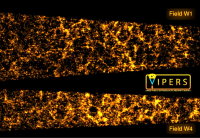Huge map of the distant Universe reaches halfway point

The largest project ever undertaken to map the Universe in three dimensions using ESO telescopes has reached the halfway stage.
An international team of astronomers, including members of the University of Edinburgh, has used the VIMOS instrument on the ESO Very Large Telescope to measure the distances to 55,000 galaxies [1] as part of the VIPERS survey [2]. This has already allowed them to create a remarkable three-dimensional view of how galaxies were distributed in space in the younger Universe. This reveals the complex web of the large-scale structure of the Universe in great detail.
By studying the cosmic web, astronomers can test theories of how the Universe formed and evolved and help to track down the properties of the mysterious dark energy that is making the expansion of the Universe speed up. Mapping how large-scale structure grows with time they can also check whether Einstein’s theory of General Relativity holds precisely, or whether it may need to be revised.
The initial measurement of this growth rate has been led by Dr Sylvain de la Torre and Prof. John Peacock at the University of Edinburgh's Institute for Astronomy, sited at the Royal Observatory Edinburgh. The results show that the strength of gravity had the same value when the Universe was half its present age as it does today; any changes over this period must be less than about 10%, which is the best current limit of its kind.
VIPERS survey
The VIPERS survey is the most detailed map yet of galaxies seen at the epoch when we believe the Universe became dominated by dark energy (as it is today). This happened between five and nine billion years ago — about half its current age of 13.7 billion years. Although it is not yet complete, VIPERS is already delivering exciting science results including a first estimate of the growth rate of large-scale structure at redshifts close to unity and the best census ever of the average number of massive galaxies at this time of the Universe’s evolution.
To mark this milestone the team is submitting this week the first set of papers to be published in scientific journals that describe the survey and the initial results. The results from VIPERS are made public for use by astronomers around the world. The current catalogue of galaxy distances will be released in September 2013.
Notes
[1] The light of each galaxy is spread out into its component colours within VIMOS. Subsequent careful analysis then allows the astronomers to work out how fast the galaxy appears to move away from us — its redshift. This in turn reveals its distance and, when combined with its position on the sky, its three-dimensional location in the Universe.
[2] VIPERS stands for the VIMOS Public Extragalactic Redshift Survey.
Further information about VIPERS, including survey press release images.

